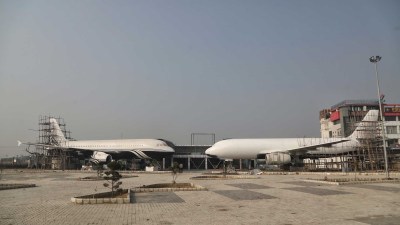A discussion with General Electric (GE) Aerospace, which started in 2012 over transferring 58 per cent technology to India for manufacturing jet engines, eventually took shape Thursday, with the former agreeing to transfer 80 per cent of the technology instead after hectic negotiations in the last few years, a top defence official said Friday.
On Thursday, GE Aerospace signed a Memorandum of Understanding (MoU) with Hindustan Aeronautics Limited (HAL) on Thursday to produce fighter jet engines for the Indian Air Force.

The announcement of the pact came during Prime Minister Narendra Modi’s state visit to the US. The final deal is expected to be signed soon after approval from the US Congress and finalisation of commercial terms.
“After 2014, there were ambitions of getting a higher percentage of technology transfer. Complete technology transfer has been agreed to on certain parameters, which was not agreed to in 2012,” the official said.
“This shows the emergence of India as a trusted partner for several nations,” the official said, adding that Defence Minister Rajnath Singh had played a major role in fuelling the signing of the agreements.
12 key technologies
As per the official, the 12 key technologies offered included special coatings for corrosion, erosion and thermal barrier for hot end, machining and coating for single crystal for turbine blades, machining and coating of nozzle guide vanes and other hot end parts, and blisk machining.
Story continues below this ad
The technologies offered also include machining of powder metallurgy discs, machining of thin-walled titanium casing, friction/inertia welding for fan and after burner, polymer matrix composites for bypass duct, machining and coating of ceramic matrix composites for nozzle guide vanes and flaps, laser drilling technology for combustor and bottle boring of shafts.
Defence officials said that out of these, GE has offered complete transfer of technology for special coatings for corrosion, erosion and thermal barrier for hot end, laser drilling technology for combustor, bottle boring of shafts, blisk machining, machining of thin-walled titanium casing, friction/inertia welding for fan and after burner and for polymer matrix composites for bypass duct.
Only limited technology transfer was offered earlier for special coatings for corrosion, erosion and thermal barrier for hot end and there was no transfer of technology offered under laser drilling technology for combustor.
Similarly, earlier when GE was to transfer 58 per cent technology, only machining was offered for single crystal for turbine blades, machining and coating of nozzle guide vanes and other hot end parts, but now coatings have been added as well. No technology transfer was offered earlier for laser drilling technology for combustor. But under the 80 per cent technology transfer, machining and coating has been added.
Story continues below this ad
Many of these technologies are critical to help retain the structure of turbine blades in high heat when a combat jet takes flight.
Only a handful of countries such as the US, Russia, the UK and France have been able to master these specialised technologies needed to manufacture an engine that can power a combat aircraft.
The F414 engines will power the IAF’s Light Combat Aircraft Mk2 jets. GE Aerospace said in a statement on Thursday that the agreement with HAL on jet engines will advance its earlier commitment to build 99 engines for the IAF as part of the LCA Mk2 programme.
The defence official quoted above said the manufacturing of the jet engine should start taking place within the next three years of signing the deal and they will be timed according to the orders placed for the LCA Mk2 and the testing of the aircraft prototype.
Story continues below this ad
“This will also likely take the indigenous content in the aircraft to 75 per cent,” the official said.
Asked if the same GE engine would power India’s futuristic Advanced Medium Combat Aircraft (AMCA) fighters, officials said they would require an engine of a higher thrust of 110 kN.
Aside from GE, India has been talking to other global jet engine makers for technology transfer such as Safran SA of France and Rolls-Royce of the UK for the AMCA. The decision on which engine would power the AMCA would be taken later, after the specifications of the aircraft are finalised.
Officials said the deal would help the Indian aerospace industry by providing access to new generation technology, new material and processes, increased indigenous content in the aircraft and lesser turnaround time for their repair and maintenance.
Story continues below this ad
The engine will also enable the aircraft to carry increased payload and fuel, advanced sensors, larger display glass cockpit, a range of indigenous weapons, wingtip missiles and will have a higher thrust to weight ratio.
A joint statement issued by India and the US on Friday stated that PM Modi and President Biden have hailed the landmark signing of an MoU between GE and HAL for the manufacture of GE F-414 jet engines in India, for LCA Mk2.
“This trailblazing initiative to manufacture F-414 engines in India will enable greater transfer of U.S. jet engine technology than ever before. The leaders committed their governments to working collaboratively and expeditiously to support the advancement of this unprecedented co-production and technology transfer proposal,” it said.
“Boosting indigenous defense capabilities”
Another key development which took place during Modi’s visit was the announcement of plans to procure General Atomics MQ-9B HALE UAVs.
Story continues below this ad
“The MQ-9Bs, which will be assembled in India, will enhance the ISR capabilities of India’s armed forces across domains. As part of this plan, General Atomics will also establish a Comprehensive Global MRO facility in India to support India’s long-term goals to boost indigenous defense capabilities,” the joint statement said.
As per General Atomics, the MQ-9 UAVs have an endurance of over 27 hours, speeds of 240 KTAS, can operate up to 50,000 feet, and have a 3,850-pound (1,746 kg ) payload capacity that includes 3,000 pounds (1,361 kg) of external stores.
Once delivered and employed, these HALE UAVs can carry out and boost the IAF’s Intelligence-Surveillance-Reconnaissance (ISR) capabilities. Armed with payloads, the weaponised UAVs will be able to strike strategic targets in mountains and the maritime domain during long-endurance missions.
The joint statement also mentioned that Modi and Biden welcomed India’s emergence as a hub for maintenance and repair for forward deployed US Navy assets and the conclusion of Master Ship Repair Agreements with Indian shipyards.
Story continues below this ad
“This will allow the US Navy to expedite the contracting process for mid-voyage and emergent repair. As envisaged in the Defense Industrial Roadmap, both countries agree to work together for the creation of logistic, repair, and maintenance infrastructure for aircrafts and vessels in India,” it said.









